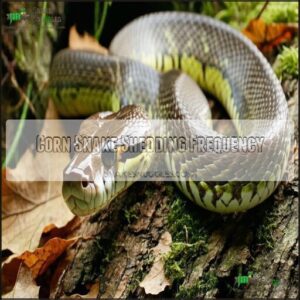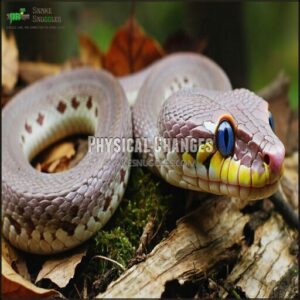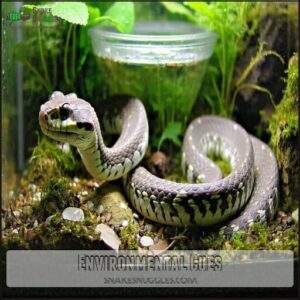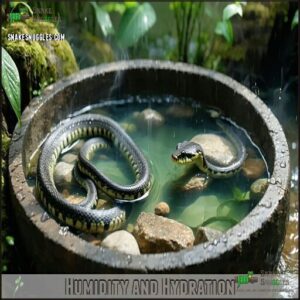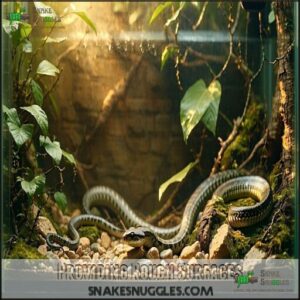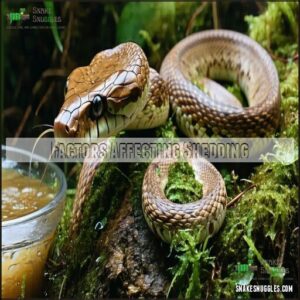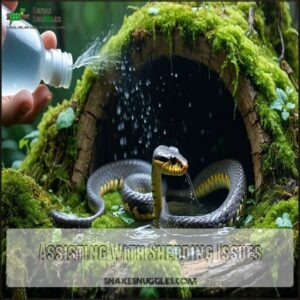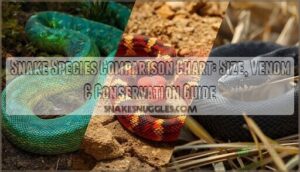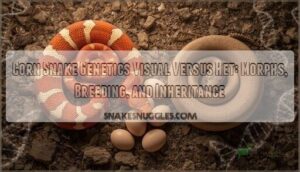This site is supported by our readers. We may earn a commission, at no cost to you, if you purchase through links.

Younger snakes shed more frequently—every 4-6 weeks—while adults shed 3-4 times yearly.
You’ll want to create the right environment by maintaining proper humidity (around 50-60%) and providing rough surfaces like branches for skin removal.
Don’t handle your snake during the "blue phase" when its vision is impaired.
If you spot incomplete sheds or stuck skin, gentle warm water soaks can help.
Watch for signs of stress or potential health issues during shedding, as this process reveals a lot about your snake’s overall condition.
Table Of Contents
Key Takeaways
- You’ll notice your corn snake is about to shed when its eyes turn cloudy blue, skin loses its shine, and it becomes less active, with younger snakes shedding more frequently (every 4-6 weeks) compared to adults (3-4 times yearly).
- Maintaining the right environment is crucial – keep humidity between 50-70%, provide rough surfaces like branches for skin removal, and avoid handling your snake during the "blue phase" when its vision is impaired.
- Your snake’s diet and overall health directly impact its shedding process, so watch for signs of stress, parasites, or infections that could disrupt the natural skin renewal cycle and potentially cause incomplete sheds.
- If you encounter shedding difficulties, gently assist by providing a lukewarm water bath, using a soft damp cloth to loosen stuck skin, and creating a humid hide with damp moss to support a smooth and healthy shedding experience.
Corn Snake Shedding Frequency
As a corn snake owner, you’ll notice your slithery friend’s shedding frequency changes dramatically with age, from every 4-6 weeks for young snakes to just 3-4 times a year for adults.
Understanding these shedding patterns is essential for monitoring your snake’s growth, health, and overall well-being, ensuring you can provide the best care throughout its life stages, which is crucial for its well-being.
Age and Shedding
Nature’s Growth Meter: Your corn snake’s shedding rhythm tells a fascinating story of life stages.
Nature’s rhythm reveals itself through the mesmerizing dance of a corn snake’s shedding cycle, marking milestones of growth and transformation.
Age dramatically influences how often your slithery friend sheds its skin. Here’s what you need to know about shedding frequency:
- Neonates shed 10-12 times yearly
- Juveniles shed 6-9 times annually
- Adult corns shed 4-6 times per year
- Younger snakes shed more frequently
- Growth spurts trigger more shedding
Each shed marks a milestone in your snake’s lifespan.
Diet also impacts shedding, influencing growth rate and overall health. Growth spurts trigger more shedding, and younger snakes shed more frequently.
Diet and Shedding
After exploring how age influences shedding, let’s sink our teeth into diet’s role.
Your corn snake’s nutrient absorption directly impacts its shedding rhythm. A balanced diet with appropriately sized prey, consistent feeding schedule, and occasional supplements guarantees healthy development.
High-quality food supports smooth shedding, while an underfed snake might struggle to shed completely, making diet a key player in your snake’s wellness journey, and ensuring healthy development is crucial.
Health Issues and Shedding
Your corn snake’s diet isn’t the only factor influencing shedding—health issues can throw a wrench in the process.
Parasites, infections, and stress can disrupt normal shedding cycles.
Watch for these red flags:
- Frequent shedding in adult snakes
- Crusty or dusty skin appearance
- Respiratory complications
- Prolonged absence of shedding
- Eye cap shedding difficulties
Dehydration and genetic factors play significant roles in shedding problems.
Signs of Impending Shed
When your corn snake starts looking a bit dull and its eyes turn a milky blue color, you’ll know it’s gearing up for a shed.
These telltale signs signal that your snake is about to go through its natural skin renewal process, so it’s time to pay close attention to its behavior and environment.
Behavioral Changes
When the shed cycle approaches, your snake becomes a master of hide-and-seek.
Shedding time turns your corn snake into a secretive, hide-and-seek champion of the reptile world.
Hiding behavior intensifies as irritability peaks, signaling imminent skin renewal.
You’ll notice reduced appetite and increased activity levels, with your serpent friend rubbing against surfaces to loosen old skin.
These behavioral changes are classic corn snake shedding signs, telling you nature’s renewal process is underway.
Physical Changes
As your snake’s behavior shifts, its body broadcasts imminent shedding through dramatic physical transformations.
Watch for dull skin losing its usual shine and eyes turning a milky blue, signaling the start of the blue phase.
Your snake’s body coloration will change, with a distinctive pink belly emerging.
These eye changes and skin covering mark the beginning of a fascinating skin replica process.
During this time, it’s essential to understand healthy shedding signs.
Environmental Cues
As your snake’s skin starts looking dull, environmental cues signal an impending shed.
Pay attention to these key factors:
- Temperature gradients can trigger shedding responses
- Humidity levels around 50-70% support the process
- Lighting schedules might influence behavioral changes
Your enclosure’s subtle shifts become a roadmap for understanding your snake’s upcoming transformation, revealing nature’s intricate shedding rhythm and the importance of environmental cues to signal the process, which is influenced by temperature gradients.
Shedding Process and Care
When your corn snake is shedding, you’ll want to provide the right environment to help the process go smoothly.
By maintaining proper humidity, offering rough surfaces, and minimizing handling, you’ll guarantee your snake can shed its skin safely and efficiently.
Humidity and Hydration
After noticing cloudy eyes and dull skin, you’ll want to nail down ideal humidity for your corn snake’s smooth shedding.
Maintain humidity levels between 50-70% using a hygrometer to monitor conditions.
Proper equipment, like a reliable snake hygrometer, is essential for maintaining these conditions.
Provide a shallow water dish for hydration and consider misting the enclosure.
These hydration methods prevent dehydration and support a successful shedding process, keeping your slithery friend healthy and comfortable.
Providing Rough Surfaces
The ingenious strategy for corn snake shedding assistance involves providing carefully selected rough surfaces.
Textured hides, bark substrates, and rock features create perfect environments for your snake to naturally remove old skin.
These abrasive elements help prevent stuck shed by giving your snake something to rub against during the shedding process, ensuring smoother, more successful skin shifts.
Boa constrictors also benefit from rough surfaces to help with removing their old skin, which is a crucial aspect of their shedding process and overall health, involving a natural and successful shed.
Minimizing Handling
After strategically placing rough surfaces to help your corn snake shed, knowing when to keep your hands off becomes just as important.
Minimize handling during shedding to reduce stress and support a smooth process.
- Observe without touching during the blue phase
- Recognize pre-shed signs like cloudy eyes
- Wait until skin is completely shed before interacting
Your corn snake needs a stress-free shedding experience, so patience is your best tool.
Factors Affecting Shedding
Your corn snake’s shedding isn’t just a random event—it’s a complex process influenced by multiple critical factors.
Understanding these environmental, health, and genetic variables will help you facilitate your snake’s smooth, healthy shedding cycles that support its overall well-being.
Environmental Factors
After perfecting your snake’s habitat setup, you’ll quickly see how environmental factors play a make-or-break role in shedding success.
Humidity levels between 50-70% are your golden ticket.
Temperature gradients matter too—provide warm and cool zones.
Your enclosure’s size, substrate choice, and lighting all influence whether your corn snake glides through shedding smoothly or struggles.
Get these right, and you’re halfway to being a pro with a well-designed environment that supports successful shedding.
Health Issues and Parasites
Shifting gears from environmental factors, your corn snake’s shedding can reveal hidden health challenges.
Parasites and infections often lurk beneath the surface, showing up as skin lesions, abnormal droppings, or shedding irregularities.
Watch for black or red dots, worms in feces, or respiratory issues.
When in doubt, consult a veterinarian for proper snake health monitoring and parasite detection.
Regular fecal examinations are essential for detecting snake parasites.
Genetic Factors
In the realm of corn snakes, genetic factors play a vital role in shedding dynamics.
Your snake’s inherited traits can substantially influence its shedding process:
- Unique shedding genes determine skin regeneration patterns
- Mutation impact affects scale morphology and shed quality
- Hybrid lineages may experience irregular shedding rhythms
- Inherited conditions can trigger unexpected shedding difficulties
- Genetic predispositions influence overall skin health and growth
Understanding these genetic nuances helps you provide customized care for your scaly companion, which is crucial for maintaining overall skin health.
Assisting With Shedding Issues
If you’re struggling to help your corn snake shed its skin smoothly, don’t worry—with the right techniques, you can make the process easier and prevent potential health issues.
Understanding how to provide the perfect humid environment, gently assist with stuck shed, and monitor for complications will guarantee your snake stays healthy and comfortable during this critical process, which involves complete concepts of snake care and prevent potential health issues.
Dealing With Stuck Shed
When a rough patch of dried skin refuses to budge, identifying stuck shed becomes essential for your corn snake’s health.
Gently assist by providing a lukewarm water bath, carefully loosening edges with a soft, damp cloth.
Many owners seek specialized shedding products to help, and if significant shedding problems persist, consult a reptile veterinarian to prevent potential infections or scale damage.
Providing a Humid Environment
After tackling stuck shed, creating the right humid environment becomes your snake’s comfort zone. Humidity is the secret sauce for smooth shedding success.
Here’s your game plan:
- Create a humid hide using damp moss
- Use a hygrometer to measure humidity levels
- Mist enclosures sparingly to boost moisture
Consistent monitoring with reliable humidity control is essential. Keep humidity between 50-70% during shedding to help your corn snake glide out of its old skin effortlessly, ensuring a successful shed in its humid environment with the right humidity levels.
Monitoring for Infections
After shedding, perform a Post-Shed Check for any Scale Abnormalities.
Look for redness, swelling, or discharge that might indicate infection. If you spot unusual symptoms, don’t hesitate to seek Veterinary Consultation.
Proper Wound Care and Preventative Measures can help avoid shedding complications.
Always monitor your corn snake’s health closely to catch potential eye infections early.
Frequently Asked Questions (FAQs)
Can shedding indicate nutritional deficiencies in snakes?
Unusual shedding can reveal nutritional gaps in snakes.
If you’re noticing incomplete sheds, discolored skin, or frequent irregularities, your snake’s diet might lack essential vitamins, minerals, or protein needed for healthy growth.
How painful is shedding for corn snakes?
Ever wonder if your snake’s skin change hurts? Don’t worry!
Shedding is a natural, painless process for corn snakes.
They’re designed to slough off old skin smoothly, feeling more like stretching than discomfort—just part of their healthy growth cycle.
What if my snake refuses to shed?
If your snake isn’t shedding properly, check humidity levels, provide a damp hide, and gently assist with stuck skin.
Consult a vet if problems persist, as incomplete sheds can lead to serious health complications for your slithery friend.
Are there risks during incomplete snake shedding?
Incomplete shedding risks serious health complications.
You’ll face potential scale damage, circulation problems, and infection if stuck skin isn’t carefully removed.
Prompt intervention prevents permanent tissue injury and guarantees your pet’s long-term wellness.
Can stress permanently affect snake shedding cycles?
Long-term stress can disrupt your snake’s hormonal balance, potentially causing irregular shedding cycles. If persistent, it might alter growth patterns and metabolic functions, requiring careful environmental management and veterinary consultation.
Conclusion
Regarding corn snake shedding, you’ve now got the inside track!
Understanding your snake’s shedding process is key to maintaining its health.
By monitoring corn snake shedding signs and help techniques, you’ll guarantee your serpent friend stays in condition.
Pay attention to humidity, provide rough surfaces, and never panic during tricky sheds.
Your careful observation and proactive care will keep your corn snake’s skin smooth, healthy, and ready for its next transformation.

